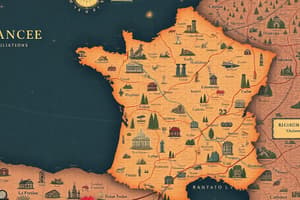Podcast
Questions and Answers
What is the primary purpose of a capital city?
What is the primary purpose of a capital city?
To serve as the administrative center of a country or region.
How does geographic location influence the choice of a capital?
How does geographic location influence the choice of a capital?
Capitals are often strategically located for accessibility and may be centrally placed for equal representation.
Name a planned capital city and its significance.
Name a planned capital city and its significance.
Brasília, Brazil, was established in 1960 to promote the development of the interior.
What does urbanization in capitals typically lead to?
What does urbanization in capitals typically lead to?
Why have some capitals been moved historically?
Why have some capitals been moved historically?
What role does climate play in the challenges faced by capital cities?
What role does climate play in the challenges faced by capital cities?
How can floods impact coastal capitals?
How can floods impact coastal capitals?
What is a shared characteristic of capitals located in diverse environments?
What is a shared characteristic of capitals located in diverse environments?
What political implications arise from the selection of a capital?
What political implications arise from the selection of a capital?
Give an example of a compromise city chosen as a capital.
Give an example of a compromise city chosen as a capital.
Flashcards are hidden until you start studying
Study Notes
Geography of Capitals
-
Definition of Capitals
- Capitals serve as the administrative center of a country or region.
- Often host government buildings, foreign embassies, and significant cultural sites.
-
Location Characteristics
- Typically situated in strategic locations for accessibility.
- May be centrally located to ensure equal representation of various regions.
- Some capitals are coastal, enhancing trade and communication; others are inland for security.
-
Historical Context
- Capitals may have historical significance influencing their selection (e.g., ancient cities).
- Some capitals have been moved due to political reasons, economic needs, or natural disasters.
-
Geographical Features
- Influenced by physical geography (mountains, rivers, and climate).
- Urbanization and infrastructure development often shaped by geographic location.
- Natural resources may play a role in the economic viability of a capital.
-
Case Studies
- Brasília, Brazil
- Planned city established in 1960 to promote development of the interior.
- Canberra, Australia
- Selected as a compromise between Sydney and Melbourne; designed to be a purpose-built capital.
- Nairobi, Kenya
- Capital due to its favorable geographic location and as a center for trade.
- Brasília, Brazil
-
Political Implications
- Capitals can be symbols of national identity and governance.
- Regions may vie for capital status to increase regional importance and development.
-
Urban Planning and Development
- Many capitals undergo continuous planning to accommodate growing populations.
- Infrastructure (transportation, housing, public services) is crucial for capital function.
-
Global Diversity
- Capitals exist in diverse environments, from deserts (e.g., Riyadh) to tropical regions (e.g., Jakarta).
- Each capital's geography influences its culture, economy, and lifestyle.
-
Challenges
- Capitals might face challenges such as congestion, pollution, and socio-economic disparities.
- Climate change impacts (e.g., flooding in coastal capitals) are increasingly relevant.
This structured overview of the geography of capitals highlights their significance and the factors influencing their locations and development.
Definition of Capitals
- Capitals are the administrative hubs of countries or regions, often housing government and foreign embassy buildings along with cultural sites.
Location Characteristics
- Strategically located for accessibility, often central to ensure representation from various regions.
- Coastal capitals facilitate trade and communication, while inland capitals may prioritize security.
Historical Context
- Selection of capitals can be influenced by historical significance, such as ancient cities.
- Capitals may be relocated for political, economic, or disaster-related reasons.
Geographical Features
- Physical geography, including mountains, rivers, and climate, significantly impacts capital location.
- Urbanization and infrastructure are shaped by geographic factors, and available natural resources can enhance economic viability.
Case Studies
- Brasília, Brazil: A planned city founded in 1960 aimed at developing the interior of the country.
- Canberra, Australia: Designed as a compromise between Sydney and Melbourne, established as a purpose-built capital.
- Nairobi, Kenya: Chosen for its advantageous geographic position and status as a trade center.
Political Implications
- Capitals often symbolize national identity and governance, influencing regional significance and development.
- Competition among regions for capital status can enhance local development and importance.
Urban Planning and Development
- Continuous urban planning is essential to accommodate population growth in capitals.
- Infrastructure development in transportation, housing, and public services is vital for a capital's functionality.
Global Diversity
- Capitals can be found in diverse environments, such as Riyadh in a desert and Jakarta in a tropical area.
- Each capital's geographical context affects its cultural, economic, and lifestyle attributes.
Challenges
- Capitals often confront challenges like congestion, pollution, and socio-economic inequality.
- The effects of climate change, including flooding, are increasingly threatening coastal capitals.
Studying That Suits You
Use AI to generate personalized quizzes and flashcards to suit your learning preferences.





